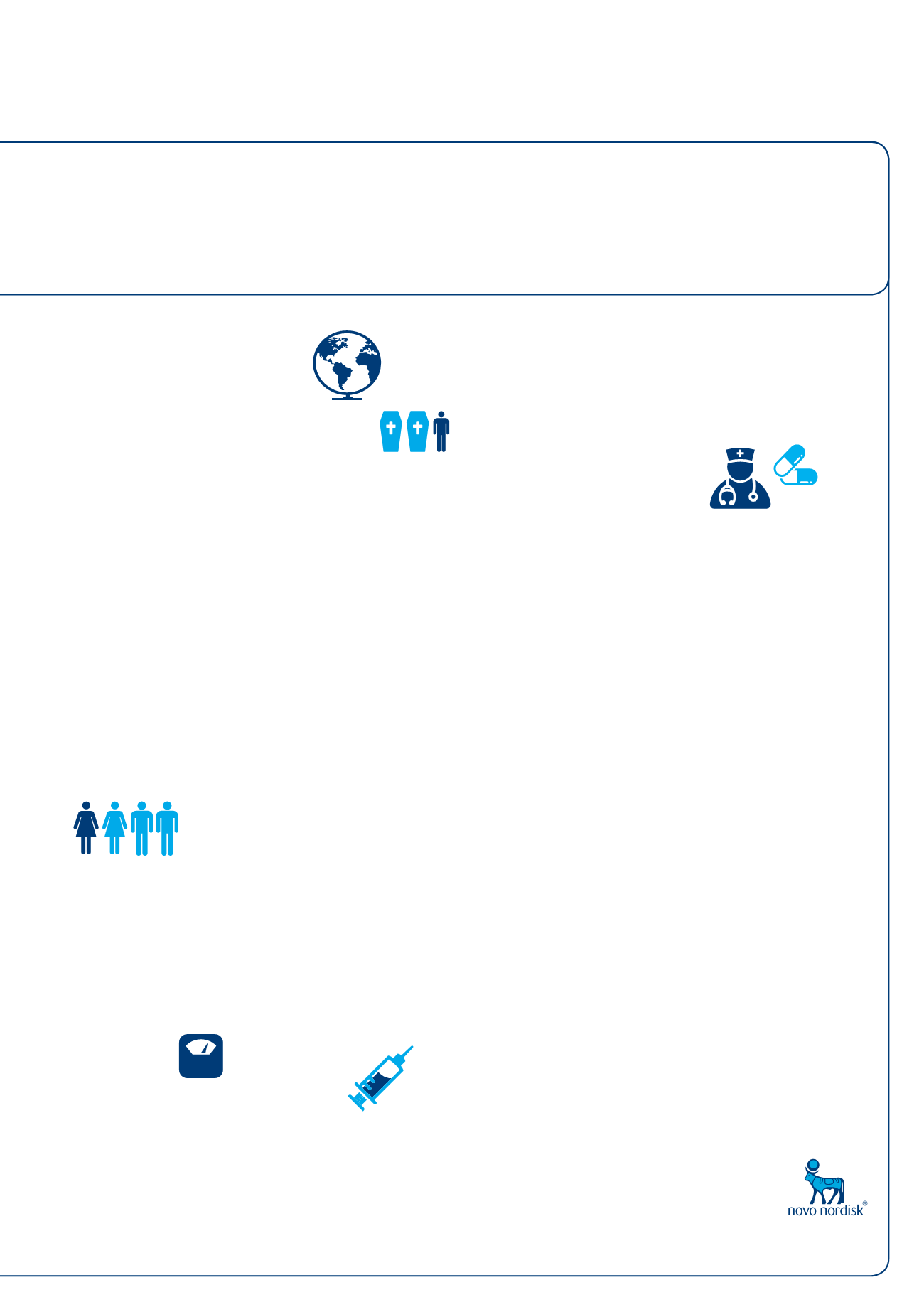

Diabetes is a global epidemic. Worldwide, it
is a leading cause of cardiovascular disease,
blindness, kidney failure and lower limb
amputation.
1. p8a; 11a; 28a
In SubSaharan Africa,
the majority of people with diabetes will die
before the age of 60. Furthermore, diabetes
accounts for almost one out of every three
deaths among the economically active age
group of 30 to 40 years.
1 p71a,73
Insulin is an effective diabetes treatment
Careful control of blood glucose can help prevent or delay micro- and
macrovascular complications of diabetes. Initially this may be adequately
achieved with lifestyle changes and oral medication, but because of
the progressive nature of diabetes, characterised by gradual decline in
ß-cell function and density, most patients will eventually require insulin
to achieve glycaemic goals.
2 p72a
Nevertheless, the benefits of control
achieved early in the disease remain for many years, despite it becoming
more difficult to maintain target glucose levels.
3 p1577a
Insulin is an effective treatment to control blood glucose. With
appropriate doses it is possible to achieve any level of glycaemic control
depending on the target set for an individual patient.
4 p197a
However, in
practice, achieving and sustaining these targets is very difficult, because
patients do not always adhere to their treatment regimen, and doctors
may be overly cautious, so that treatment is not intensified when it
needs to be.
5 p38a, b
Patient considerations
In fact, a substantial proportion of patients
with type 2 diabetes do not achieve
internationally recognised glycaemic
targets.
5 p38a
Even in some South African
specialist clinics, adequate glycaemic control
is achieved in no more than about 1 in every
4 patients with diabetes!
6 p154a
Of course, nonadherence to therapy is an important problem
associated with chronic diseases. Nevertheless, there are also specific
reasons why diabetic patients may be reluctant to initiate or intensify
antihyperglycaemic medication. Some of these include feelings of failure
about suboptimal glycaemic control, anxiety about hypoglycaemia or
weight gain, and fear of injections. Poor education about type 2 diabetes
and the importance of treatment can exacerbate nonadherence.
5 p38b
In addition to consideration of their patients’ concerns, clinicians
themselves may have reasons to delay initiation or intensification
of insulin therapy in a patient who needs it. This is a worldwide
phenomenon, sometimes referred to as ‘clinician inertia’.
5,7 5.p38b; 7.p2675a
Causes range from time and resource constraints to underestimation of
the patient’s needs, and failure to identify and manage comorbidities.
Physicians may be afraid of causing harm and be overly cautious when
prescribing so as to avoid weight gain and hypoglycaemia, especially
in patients who already have comorbidities.
5,8 5.p39a; 8. p17a
They may be
concerned about patient non-compliance, or merely not know how
to manage a patient who simply refuses to entertain the thought of
escalating treatment.
8 p17-18a
Accordingly, oral therapies are continued
for as long as possible, in the hope that patients will implement lifestyle
changes.
9 p370
Physician-related barriers to timely
initiation of insulin
8
•
Concerns over patients with comorbidities
•
Excess weight gain in already overweight patients
•
Concerns about patient non-compliance
•
Risk of severe hypoglycaemia/adverse effects on quality of life
•
Lack of resources
•
Patient refusal
Novo Nordisk seeks to dismantle barriers to
insulin prescribing
In response to these complex challenges, Novo Nordisk is leading the
way in developing new molecules and delivery devices to change the
way people with diabetes, and their healthcare providers, think about
insulin. Novo Nordisk understands that if treatment regimens can be
made simpler and more comfortable, and concerns over side effects no
longer get in the way of efficient glycaemic management, then life with
diabetes will be simpler, less scary and of a much better quality than it
has ever been before.
References
1. International Diabetes Federation. IDF Diabetes Atlas, 7th edn. Brussels, Belgium:
International Diabetes Federation, 2015.
http://www.idf.org/diabetesatlas.Accessed
11 May 2016.
2. Henske JA, Griffith ML, Fowler MJ. Initiating and titrating insulin in patients with type
2 diabetes. Clin Diab 2009; 27(2): 72-76.
3. Holman RR, Paul SK, Bethel MA, et al. 10-year follow-up of intensive glucose control
in type 2 diabetes. N Engl J Med 2008; 359: 1577-1589.
4. Nathan DM, Buse JB, Davidson MB, et al. Medical management of hyperglycaemia in
type 2 diabetes: A consensus algorithm for the initiation and adjustment of therapy.
A consensus statement of the American Diabetes Association and the European
Association for the study of Diabetes. Diabetes Care 2009; 32(1): 1-11.
5. Ross SA. Breaking down patient and physician barriers to optimize glycemic control in
type 2 diabetes. Am J Med 2013; 126(9 Suppl 1): S38-S48.
6. Pinchevsky Y, Butkow W, Raal FJ, et al. The implementation of guidelines in a South
African population with type 2 diabetes. JEMDSA 2013; 18(3): 154-158.
7. Peyrot M, Rubin RR, Lauritzen T, et al. Resistance to insulin therapy among patients
and providers. Results of the cross-national Diabetes Attitudes, Wishes, and Needs
(DAWN) study. Diabetes Care 2005; 28: 2673-2679.
8. Kumar A, Kalra S. Insulin initiation and intensification: insights from new studies. JAPI
2001; 50(Suppl): 17-22.
9. Wallace TM, Matthews DR. Poor glycaemic control in type 2 diabetes: A conspiracy of
disease, suboptimal therapy and attitude. QJM 2000; 93: 369-374.
Novo Nordisk South Africa
How can we overcome barriers
to effective glycaemic control in type 2 diabetes?
Adequate glycaemic control
is achieved in no more than
about 1 in every 4 patients
with diabetes
Nonadherence through
anxiety of weight gain
fear of injections
Physicians overly cautious when
prescribing so oral therapies are
continued for as long as possible
Diabetes
is a global
epidemic
1 out of every
3 deaths in
30-40 year olds

















